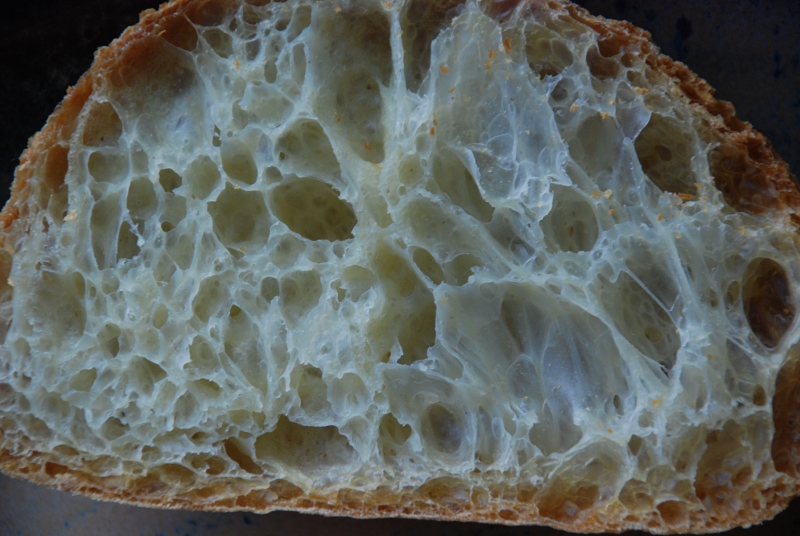
Way back when, Sylvia posted a pugliese with a lighter than air crumb. I baked it once and loved it, then forgot about it. Browsing through old bread pictures the other day I came upon a photograph of my old pugliese, and decided to try it again. However, I couldn't leave well enough alone and follow the recipe. Instead, I tweaked it just a little.
The original formula calls for poolish, and yet, there was ripe starter sitting on the counter with no label other than discard. Should I discard it or did it have a place in this little pugliese? The problem with using starter for a bread like this is that it takes up too much of the flavor room and masks the delicate taste of the durum. A baking error one might say. Not wanting to fall into this trap, I decided to use some of the starter, but handle it very carefully to keep the flavor nice and balanced.
I fed the starter with some fresh flour and let it ferment for just long enough for it to start expanding, but not long enough to build up a heady aroma. At that point, I mixed everything up, and proceeded as directed.
This dough was very wet and somewhat difficult to handle. I developed the dough by mixing at speed 1, 2, 3, 4 (!) in my Bosch Compact for a total of 6 minutes. By the end, it had cleared the bowl but was very wet and sticky, and spread out again as soon as I let it rest. I did stretch and fold in the bowl twice at half hour intervals, and for the third S&F after 30 more minutes, got my hands very wet and picked the dough up and suspended it and rotated it.
I "shaped" the dough into a boule, which is similar to saying that one shaped a water balloon - more like a little prod here and a poke there, dusted it with durum flour and proofed upside down in a ceramic bowl. It swelled up over the sides of the bowl (doubling in size) in an hour at which point it went into the oven unscored, as there was just no point in poking at it.
It came out nicely - self scoring along the way - and had the subtle flavor I had hoped for, with a light, tender crumb and a crisp crust. All in all, a pleasant flavor variation from the original but still a pugliese at heart.

Formula and method:
Note: fixed formula error - reversed amounts of KAAP and Durum in final.
Poolish / Starter | | Feeding | Total | |
Seed | 65 | | | |
KAAP | 39 | 45 | 84 | |
Water | 26 | 40 | 66 | 79% |
| | | | 150 | |
| | | | | |
| | Final | Poolish | Total | Percent |
KAAP | 73 | 82 | 162 | 65% |
KA Durum | 85 | | 85 | 35% |
Water | 134 | 64 | 198 | 83% |
Salt | 4 | | 4 | 1.9% |
Yeast | 2 | | 2 | 0.9% |
Poolish | 146 | | | |
| | | | | |
factor | 0.97 | | | |
Total Flour | 240 | | | |
Dough Weight | 445 | | | |
Final weight | 354 | | | |
Shrinkage | 80% | | | |
Prefermented flour | 16% | | | |
Mix poolish. Ripen for 3.5 hours
Mix ingredients 6 minutes, increase to speed 4
Dough cleans bowl but still wet and sticky
S&F in bowl every 1/2 hour 3 times - final in the air
BF total of 2 hours 45 minutes - dough will have expanded
Shape into boule on counter dusted with durum flour
It is very squishy like a balloon
Proof in dusted bowl for1 hour - dough doubles
Bake with steam for 5 minutes (oven preheated to 500 then turned off)
then at 450 for 35 minutes